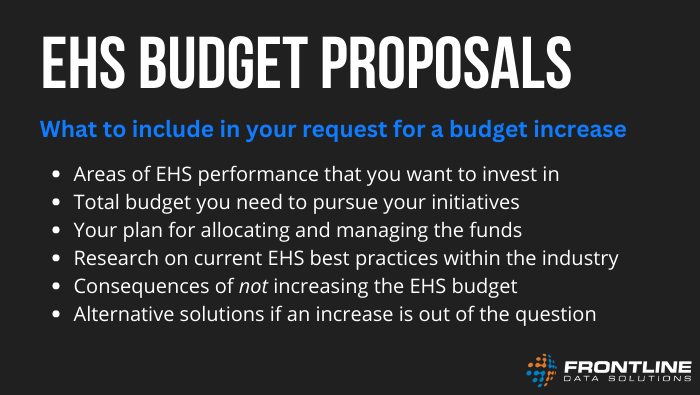Are you struggling to get your senior leadership team to buy into an increased budget, new equipment, or even the EHS basics like industrial hygiene testing?
If so, you’re not alone in this frustration.
There are few companies who actively invest in their health and safety departments. In fact, many companies actively try to reduce their spending in this area, viewing EHS expenses as the necessary evils of regulatory compliance.
But smart investments in things like EHS software or process automation technology, for example, can reduce a company’s risk exposure. And they can also help reduce department headcounts by eliminating the administrative burden of compliance reporting.
If you’ve identified some areas where you’d like to increase your budget but need buy in from senior leadership to do it, I want to share some tips for pleading your case.
Deep diving your budget
Before you ask for anything, you need to dive into your current situation. Start by looking at your department budget as it is.
Go through each line item separately to see if there’s any place where you have excess that you can reallocate. If you do, it may be easier to propose a budget reallocation than an increase. If you don’t have any excess, consider whether you can make room by cutting costs in certain areas.
The reason I recommend starting here is simple:
It’s much easier to get buy in from senior leadership when you don’t have to increase your budget. Pitching a reallocation of funds to more critical areas is a concept that most top leaders can get behind.
Anticipating roadblocks
If you’re unsuccessful in finding money to reallocate, you need to anticipate any roadblocks you may encounter when presenting your proposal to senior leadership.
Do this by making a list of all the pushbacks you expect to receive. For each roadblock, write your counterargument and how the additional funding will solve problems within the operation.
You want to consider how the leadership team currently thinks about and invests in safety measures.
How does senior leadership currently view you, your team, and the profession in general?
Additionally, is your company undergoing any financial hardships?
Ask yourself if this is a good time to present your case. If so, your proposal should include information on how the money will:
- Reduce risk
- Lower incident-related expenses
- Improve operational efficiency
- Help quality management
- Develop employees
Let’s talk some more about how you can put together a persuasive budget proposal.
Preparing a winning proposal
After deep-diving your departmental needs, it’s time to decide how you will approach the subject with the leadership team.
This starts with determining the tone of the pitch. There are two main ways to frame your argument: the negative angle or the positive angle.
Negative angle
This approach involves spelling out all the negative things that might happen if you don’t get the funding you want. It focuses on things like:
- Incident rates
- Workers’ compensation claims
- Downtime
- Fines
Your goal with this approach is to create a sense of urgency: “If I don’t invest more in this area, X, Y, and Z will happen.”
Positive angle
A different approach is to make the positive benefits of a budget increase the focal point of your argument. This includes variables like:
- Employee morale
- Company performance
- Customer experience/satisfaction
- Employee retention and engagement
Your goal with this angle is to create a sense of optimism: “If I invest more in this area, X, Y, and Z will happen.”
Striking a balance
I recommend using both approaches together, which will require some prior planning. Here are some questions to help you brainstorm your talking points:
- What does senior leadership care about?
- What are the major company-wide goals and initiatives for the fiscal year?
- Do leaders care about competitor benchmarking?
- Does the leadership team have a track record of supporting preventative strategies?
This is also the time to think about any past experiences you might have had making the same request. Reflect on the reasons why top management rejected past proposals and whether the situation is more urgent now.
Research your request by performing time studies, analyzing past EHS data, and conducting risk analyses. Having all this data before you make your pitch can speed up the decision-making process.
Looking beyond safety
Don’t forget to bring in other aspects of the business, like quality and productivity, when you set up your request. Show the leadership team that what you’re asking for will contribute to lasting results.
From my personal experience, a large majority of executives focus on financial performance more than anything else. That’s why you need to explain how a bigger EHS budget can reduce costs long-term by:
- Improving efficiency
- Automating tedious workflows
- Preventing costly incidents
- Reducing quality errors
- Increasing productivity rates
The timing of your presentation, or pitch, will be a large part of whether you succeed in obtaining your budget goals. If you’re asking for a budget increase after budgets have been set, it may take a little more convincing than if you were to ask for the budget increase in advance of the fiscal year end.
Something else you may think about is getting buy in from other departments or managers before you speak with top management. This will help strengthen your argument.
Basic budget proposal outline
This is a simple outline of all the talking points you should cover when you propose a budget increase:

- Problem(s) you want to tackle
- Outcome(s) you want to achieve with more money
- Benefits of your initiatives
- Total budget needed to pursue your initiatives
- How you will use the money
- What other companies are doing successfully in this area of EHS performance
- What will happen without an increased budget
- Alternative solutions if a budget increase isn’t possible
If your solution is based on any assumptions, you’ll want to share those as well. Providing context is essential for the senior leadership team to understand the necessity of your proposal.
Final thoughts
A deep dive into your current budget may reveal that all you need are reallocations, not increases. If you do, however, decide to propose an increase in your department’s funding, a thoughtful proposal is necessary to get buy in from senior leadership.
Make sure you do your homework on the costs and benefits associated with the investments you’re interested in. Ultimately, your job as a safety professional is to ensure the safety of your company’s employees. If the tools and programs you need in order to do your job effectively stay on the “wish list,” you haven’t done your job as effectively as you can.

Jason Hathcoat
Jason is a seasoned EHS professional with more than 17 years of experience working in health and safety. He currently works as an EHS manager for a large global HVAC company.
Other posts you might like…
No posts

